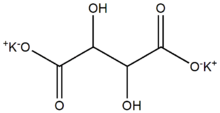Potassium tartrate
Potassium tartrate, dipotassium tartrate or argol has formula K2C4H4O6. It is the potassium salt of tartaric acid. It is often confused with potassium bitartrate, also known as cream of tartar. As a food additive, it shares the E number E336 with potassium bitartrate.
 | |
| Names | |
|---|---|
| IUPAC name
Dipotassium 2,3-dihydroxybutanedioate | |
| Other names
Dipotassium tartrate; Argol; E336 | |
| Identifiers | |
| |
3D model (JSmol) |
|
| ChemSpider | |
| ECHA InfoCard | 100.005.180 |
| E number | E336 (antioxidants, ...) |
PubChem CID |
|
| UNII |
|
| |
| |
| Properties | |
| C4H4K2O6 | |
| Molar mass | 226.268 g/mol |
| Appearance | colorless, slightly opaque crystals |
| Density | 1.984 g/cm3 |
| Solubility | insoluble in alcohol |
Refractive index (nD) |
1.550 |
| Structure | |
| monoclinic | |
Except where otherwise noted, data are given for materials in their standard state (at 25 °C [77 °F], 100 kPa). | |
| Infobox references | |
Manufacturing
Potassium tartrate is produced by the reaction of tartaric acid with potassium sodium tartrate (rochelle salt), and potassium sulfate, followed by filtration, purification, precipitation and drying.
Other compounds
Tartar emetic is produced when potassium tartrate is heated with antimony trioxide. Tartar emetic causes intense nausea, prostration and vomiting by irritating the gastrointestinal mucosa.
gollark: Isn't honey basically just orange sugary stuff?
gollark: You just need unreasonable amounts of slaves.
gollark: But then you need even MORE slaves to harvest and manage the plants.
gollark: Even if you can live entirely on those, it would be unhealthy and thus worsen the slaves, and producing that at the necessary scales would still be polluting.
gollark: But climate change is caused by greenhouse gases, which slaves produce, as does their food production.
This article is issued from Wikipedia. The text is licensed under Creative Commons - Attribution - Sharealike. Additional terms may apply for the media files.